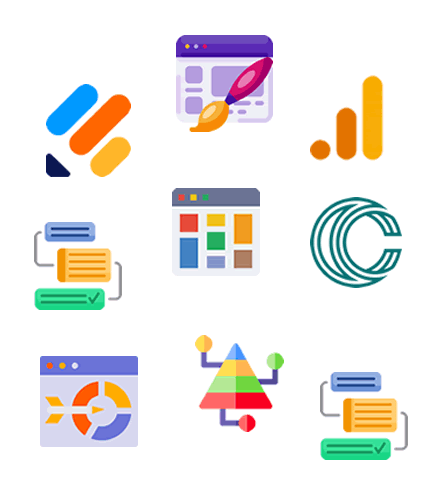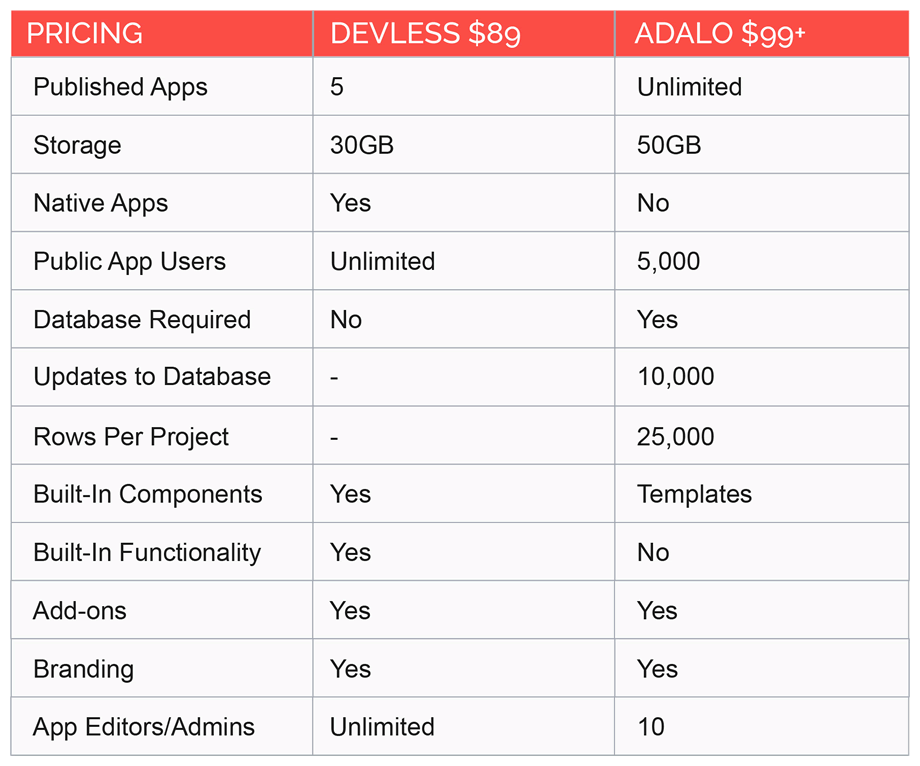Glide vs Devless: Start Creating Apps for Free
Glide and Devless offer powerful, no-code tools to start creating apps for free. Their ease of use for everyone is a huge step toward increasing software accessibility, which we resonate with. However, they have different strengths that make them better suited for different types of projects. When deciding between the two app platforms, it's important to consider your project’s needs and budget before making a final decision. This article will compare them so you can discover the reasons why Devless is likely the best fit and will be easier to use for DIY app development.


#1 User Interface: Devless’s Form-Based UI is More Intuitive
No matter how you spin it, drag-and-drop editors are complex and time-consuming. The average person without a tech background lacks enough knowledge to build apps fast with them. Glide has made its drag-and-drop interface as simple as possible, but that comes at a cost of limited customization. Regardless, be careful of choosing any drag-and-drop app builder because you'll spend far too much time building your app's UI rather than getting to market.
No-code platforms like Devless offer a different UI experience to empower anyone to stand up a working application quickly. Because business owners want to hit the ground running, Devless opted for a simpler UI than drag-and-drop. Its dashboard harnesses a form-based user interface that takes a fraction of the time to get accustomed to. It doesn't overwhelm users with too many options and doesn't limit them to the bare minimum either — the Devless UI is just right. With a low learning curve, it lends confidence, has plenty of customization, and delivers immediate results with less effort!
#2 App Design Process: Speed Up Development with Devless
After learning a platform's UI, the next step in the app development process is to design the app. This means building out each screen and adding every component in a way that follows UI best practices. Don't forget, depending on the platform, you may need to design for multiple device types to make responsive applications. Wouldn't it be nice if your app-building software took care of all of this for you? Devless does.
Glide does not afford you the luxury of skipping design, but does offer templates that are especially helpful to users. Unfortunately, they won't be perfect for every business out there and will still require a lot of work like building out additional screens and adding components — all things you don't have to think about with Devless.
Additionally, Glide “Apps” do not look as good on tablets or desktops. To accommodate users, Glide is producing a new product called Glide “Pages” that are responsive, but currently lack many features of their “Apps”. In case you're wondering, no, Apps cannot transfer into Pages. They are completely different products that require separate builds.
Fortunately for you, Devless recognizes good design is incredibly important. It's just one reason users opt for Devless over Glide. Devless gives you the advantage of automatically having a UI built according to best practices no matter how you create your app. All Devless apps are responsive too. You get to skip the struggles of design and go straight to customizing by making simple selections for layouts, colors, visibility, etc. For Devless users, this means if you know how to use a dropdown or a toggle, you've got it made!
#3 Programming Functionality: Opt for Ease of Use
After app design, comes programming your app's functionality which is often the most dreaded part of the app development process when using drag-and-drop editors. This step is important because it ensures users can navigate your app, access the right content, and use its features. Take note: Glide specializes in turning spreadsheet data into apps, and that is not the focus of Devless. Instead, Devless apps offer flexibility when it comes to business app ideas. Here's the difference in how each app builder approaches functionality…
For Glide, programming functionality begins by choosing a backend database and configuring sections of an app to display specific data. The current choices are Glide Tables, Airtables, Google Sheets, and Excel. The next step is adding data, navigation, communication, and advanced actions so end users can interact with your app.
It is nice how Glide instantly creates an app once it's hooked up to a database, but unfortunately, there's still too much work left to be done. Consider tasks like modifications to the database, customizing app actions, integrating workflows, and setting parameters (just to name a few).
If the type of app you need requires database management, like inventory tracking, Glide is an easier app builder than many out there. But be cautious, because you'll need to know the limits of your skill set in case custom app actions are needed for your workflow. You may end up needing to hire a Glide developer to finish what you started.
If you don't like the sound of all of that, then Devless will save you the hassle. You get to skip database management and programming functionality altogether! The functionality of components is built-in, all you have to do is add content (resources) similar to the way you'd put files within folders in Google Drive. Pretty easy, right?
And to expand your Devless app's functionality, simply enable add-ons like tagging, guided support, and Jotforms which are a cinch to implement. Using plugins to tell your app what to do with your resources is a much easier and faster way of building an app. You can be 100% certain you won't have to code or be faced with a steep learning curve of any kind.
#4 Web App Customization: Get Exclusive Engagement Tools
Since Glide is a no-code tool that strictly uses templates, there are some limitations in what you can build, and not every business needs to transform spreadsheets into apps.
Glide Apps do not allow you to add individual components, and it's limited to the customization of colors, text, and layout. According to some reviews, it doesn’t have enough flexibility to provide the features and the user experience that its users want to provide customers in the long run. Even though Zapier is a great integration option, some small businesses don't have a use for it or don't want to pay for an extra service.
As a better alternative, Devless gives exclusive engagement tools like Guided Support that offer end users a unique experience tailored to any business. There are endless ways to create guides, and they serve end users of apps 24/7. Businesses use them to offer personalization, FAQs, how-to guides, internal scripts…you name it! Devless integrations are also easier and cheaper. For example, enabling Jotforms is done via API so you don't have to pay for Zapier and track zaps.

#5 Analytics: Devless Gives Deeper Insights
Every business app needs powerful analytics. Both builders allow Google Analytics integration, but Glide requires a more expensive 'Pro' plan to use it.
Glide does not offer a custom analytics dashboard. Instead, it offers only a 'Usage' tab that tracks your account limits. This is broken down to reflect row usage, update usage, private and public user sign-ins, number of published projects, and file storage.
Devless does better. Beyond Google Analytics, you also get its custom analytics dashboard that tracks user login sessions and activity. Plus, its heatmaps are a cool visual to allow you to quickly interpret data. There are also no worries about tracking internal usage as Glide does for updates, rows, etc.

#6 Native Applications: Only Devless Gets You in the App Stores
The problem for many users is that Glide Apps are not native apps. Glide emphasizes the benefits of their instant publishing over downloads and installs. What they don't tell you is that you're missing out on reaching the massive number of potential users that could be finding your brand in the app stores. Sure, web apps work across all devices, but we all know many users prefer native apps for Android and iOS.
Devless publishes web apps instantly too, but its support also helps users get their apps listed in the Google Play Store and/or the Apple App Store. This way business owners can accommodate customers' preferences and have more brand visibility. The best part is that Devless eliminates the need to create separate native applications. You'll get an Android app and an iOS app from one simple build.
#7 Customer Support: Trust Devless to Not Charge You
It's hard to believe that Glide users must purchase personalized onboarding if desired. The cost doesn't appear to be stated. This seems like a harsh way of getting new users to be resourceful with available documentation and using community/email support. Despite this, their service has great reviews and they document well.
Another odd charge sneaks up in the event you need to hire one of their Glide experts. Users are required to complete a 15-minute kick-off call that will cost you about $20, like it or not. The expert will determine if your project is a good fit for Glide first, then proceed. If they don't think it is, it sounds like you pay anyway and you're back to square one. It makes you wonder though if the Glide platform was truly no-code and easy, why should you need an expert?
Devless is always transparent and does not charge for any kind of support. Anyone can request a free demo or consult. In addition to using Devless's Help Center full of videos and help docs, users can reach support via email. You'll always get personalized help any time you need it.
As far as hiring experts, Devless is truly committed to providing simplicity for all its users and is meant to be a 100% “developerless” solution. This keeps the price low for business owners and empowers them to be successful from start to finish.
#8 Free Plans: A Great Way to Test Drive No-Code App Builders
Get signed up for free today, no credit card is required! Both Devless and Glide offer instant publishing and you can upgrade at any time to take advantage of generous limits, white labeling, and additional features for your business app.
#9 Paid Plans: Be Cautious of Usage Limitations
Glide has five paid plans for individuals and businesses which vary according to usage. Only “Updates” can be purchased as overages. If you need more “Rows” per project or “Users”, you will need to upgrade to the plan that fits your needs. Devless pricing is straightforward and has three paid plans.
Below, we compare Glide's Pro Plan with Devless's Business Plan. These plans are best suited for small businesses. Here's how they stack up.

Conclusion
Start creating apps for free to test out each app builder's features and decide which one is the best fit for your needs. Both Devless and Glide offer users the ability to quickly publish applications, but when we look at the paid plans there are some key differences. Devless offers you native apps in the app stores along with unlimited public app users and editors. Remember, no database management is required! Unlike Glide, Devless's built-in components and functionality allow you to fast-track app development with ease. Give it a try today!
